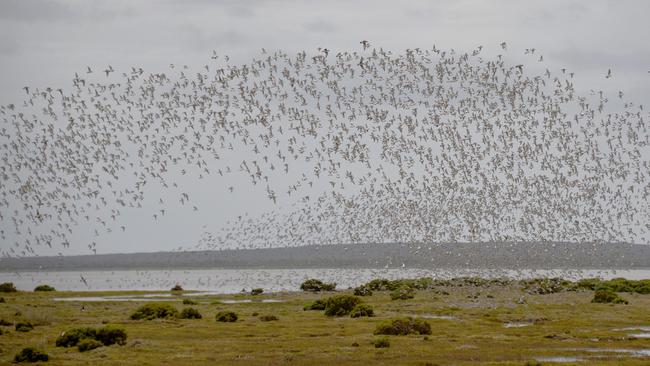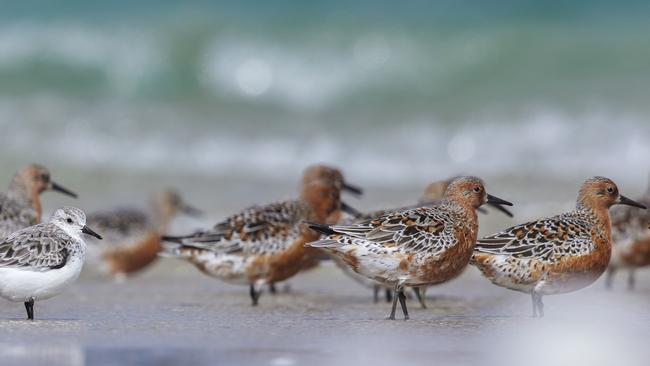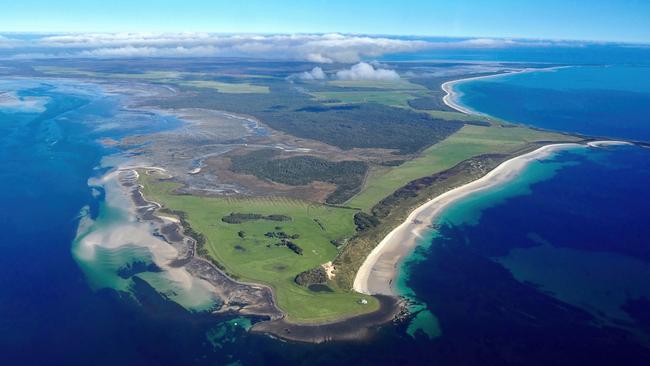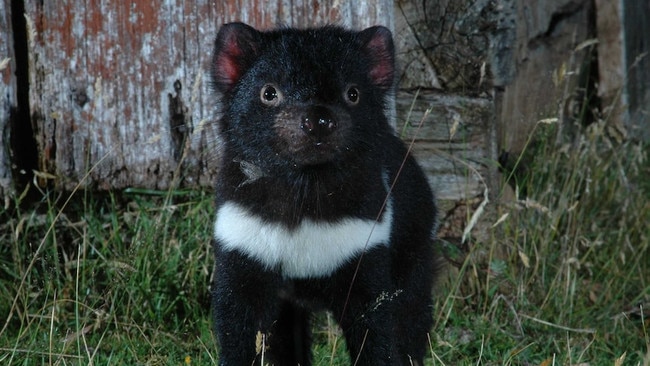Future of Robbins Island oasis blows in winds of change
Conflict looms between the island’s standout features – a wind resource unencumbered by land from South America to Tasmania, on the one hand, and precious biodiversity, on the other.

In a lonely corner of Bass Strait, an island battered by the roaring forties provides a haven for legions of migratory and resident birds and for the last wild, disease-free Tasmanian devils.
If you haven’t heard of Robbins Island, visible from Tasmania’s far northwest, you soon will.
Conflict looms between the island’s standout features – a wind resource unencumbered by land from South America to Tasmania, on the one hand, and that precious biodiversity, on the other.
ACEN Australia, ultimately owned by Philippines property developer Ayala, plans to build a $1bn wind farm of up to 900 megawatts, with 100 turbines, on the 9900ha island.
The wind farm, along with a further 31 turbines at a nearby site on the Tasmanian mainland, would generate enough electricity to power 700,000 homes.
That energy would not only be available to benefit Tasmanians, but could be exported to Victoria, via a proposed second power interconnector under Bass Strait.
However, Robbins Island is more than a potentially profitable wind resource. It and surrounding areas are rated as the most important shorebird site in Tasmania, home to more than 25,000 shorebirds during summer months, and thought to be a major migratory staging point.

There are resident Tasmanian wedge-tailed eagles and white-bellied sea-eagles, and one of the world’s rarest birds, the migratory orange bellied parrot or OBP, has been spotted on the island.
At ground level, the island hosts what is now thought to be the only remaining wild population of Tasmanian devils free of the devil tumour disease estimated to have wiped out up to 80 per cent of the iconic species.


Inquirer has received evidence the disease has now reached areas on the mainland near the island, leaving Robbins a lone bastion against the cancerous plague.
ACEN’s plans include a 1.2km bridge to Robbins; a potential highway for the disease to spread to the island’s so far healthy 150 or so devils.
Former Greens leader Bob Brown says while he is supportive of renewable energy, it must not involve driving species towards extinction. “We’re not only in a global warming crisis, we’re in an extinction crisis – and it’s advancing at least as fast,” Brown tells Inquirer.
“Here on one little island is a terrible prospect of big advances towards extinction of the OBP, one of the rarest birds on Earth, while the Tasmanian devil is likely to have its last natural stronghold taken away from it.
“And a brace of a dozen or so endangered shorebirds, which fly form Alaska and Siberia to feed on the mudflats around Robbins Island, face 100 to 200 wind turbines – essentially a series of meat slicers.
“We are in a rapid revolution and transition to renewable energy and we have to be, but it has to have a social licence.”

However, in late November ACEN secured a major win: successfully challenging a condition imposed by the state Environment Protection Authority that it shut down the turbines for five months a year to avoid blending OBPs during their migration.
The condition would have rendered the project unviable and the company’s triumph in the state’s planning court, known as TASCAT, was a badly needed fillip for the wind industry more broadly.
Community opposition had just sunk another wind farm a little further afield at Stanley and the EPA’s tough stance appeared to signal a new hardline regulatory approach.
With its political backers, the powerful sector is now on the offensive; pushing for streamlined regulation to avoid further such hindrances to the great Australian wind rush.
Even so, what has become a flagship project for the wind sector is far from done and dusted, with ACEN yet to receive federal environmental approval.
Opponents are turning to federal Environment Minister Tanya Plibersek to, as they see it, bring ACEN, the industry and the pro-wind Tasmanian government into line.
“It just shouldn’t go ahead because of the high level of uncertainty about impacts at every level,” argues Mark Holdsworth, an ornithologist who spent 25 years leading efforts to bring the OBP back from the brink of extinction.
“Essentially, TASCAT has been persuaded to take the risk, which I don’t think is the way to go for the OBP, which is so critically endangered. The population has only just started to get a bit of a foothold – 81 birds now from a low of 17.
“But that could easily turn around and go backwards very quickly. Forget about TASCAT, that’s just a planning decision. The conservation power now rests with Tanya Plibersek. So the big question now is: Does the commonwealth want to take that risk?”


There are reasons to believe Plibersek’s environment department, at least, does not.
The EPA’s five-month shutdown provision, overturned by TASCAT, was based on concern from Plibersek’s department about impacts on the OBP, while it has separately demanded ACEN provide a plan to offset its proposed destruction of 366ha of devil habitat on the island.
EPA documents reveal Plibersek’s department told it in June 2022 that it remained concerned “impacts to the Tasmanian devil and OBP had not been adequately considered and addressed consistent with the (federal) Environment Protection and Biodiversity Conservation Act”.
“When commonwealth assessment requirements are considered, the following conclusions are reached: the project will result in unacceptable impacts to the OBP and significant residual impacts to the Tasmanian devil,” one document concludes.
“The impact to the OBP would be unacceptable, primarily because approving the proposed action would be inconsistent with the National Recovery Plan for the OBP.
“The (federal) minister must not act inconsistently with a recovery plan.
“No feasible measures are available that would reduce the impact to the OBP to an acceptable level.”
The verdict on devils was similar: “Following the implementation of the proposed avoidance and mitigation measures, a significant residual impact to the Tasmanian devil will remain. No offset proposal consistent with the department’s offsets policy has been provided by the proponent to compensate for this.”
Overall, taking into account Plibersek’s federal legislative responsibilities, it concluded “it may be that the recommended precautionary measure would be to refuse the proposal”.
Opponents believe these federal concerns have not gone away and should kill the project; an eventuality that would be a loud alarm bell for the wind industry nationally.
It could also pit minister against minister – wind champion Climate Change and Energy Minister Chris Bowen against Plibersek, who has pledged not to allow any more species extinctions on her watch and to modernise national environmental laws.
ACEN argues diseased devils can already cross to the island via sandbars at low tide, but the department – and some devil experts – are not convinced this justifies providing them a means to do so much more readily.
In October 2021, the federal department took issue with ACEN’s claims that the Robbins Island devils were not isolated. “The department disagrees,” bureaucrats warned in unusually blunt language.

“DCCEEW (Department of Climate Change, Energy, the Environment and Water) notes that a geographic barrier separates Robbins Island from the mainland. DCCEEW notes that while occasional gene flow may be possible via individuals crossing on sandbars at low tide, the absence of devil facial tumour disease on the island clearly suggests that any potential movements from the mainland are occurring at a very low frequency.”
Plibersek’s department refers again to the Robbins devils’ unique disease-free status in its April 2023 demand that ACEN detail how it can offset devil impacts.
Documents suggest those advising Plibersek cannot see how ACEN can properly offset the loss of habitat for the world’s last isolated, high-density, disease-free devils. “No ‘like for like’ habitat exists,” one official wrote.
It seems a devil of a problem for ACEN, but chief executive David Pollington is unfazed and bullish about a positive decision from Plibersek early in 2024.
“I think there’s a significant amount of misunderstanding about the perceived impact for Tasmanian devils,” Pollington says.
The bridge will include design features including “unscaleable” gates to deter diseased devils accessing the island, he says, while maintaining it’s not a significant issue, in any event.
“They already cross back and forth – our trapping process identified devils that had been tagged at Woolnorth (nearby mainland location) that were on Robbins Island,” he says. “There’s photographic evidence of them crossing at low tide … The bridge makes absolutely no difference.”

Pollington argues the disease has only very recently arrived on the island’s doorstep, making “a nonsense” of the argument its absence demonstrates the island devils are isolated.
Devil expert Nick Mooney, a wildlife biologist, agrees that devils have over time crossed between the mainland and Robbins at low tide.
However, he argues putting a bridge in place and allowing far greater exchange between the populations is a very different proposition, potentially undermining small but important genetic differences between them.
“Devils seem to have survived devil facial tumour disease due to small genetic differences – so you are better off trying to conserve those small differences,” Mooney explains.
Despite the department’s concerns about the loss of 366ha of devil habitat, Pollington argues the impact is “extremely minimal” and that some of the area to be lost is pasture.
“The commonwealth at the moment is trying to look at how they apply their offset rules to arguably an issue that doesn’t actually exist,” Pollington says.
ACEN flags placing a covenant on another part of the island to protect devil habitat from development as an offset. “The highest densities (of devils) are on the eastern part of the island, where the wind farm isn’t,” Pollington argues.
However, Mooney backs the view that offsets may not be possible, due to the absence of any other such isolated, disease-free habitat. “I can’t see an offset for the habitat loss,” he says. “You can’t increase the population somewhere else.
“It’s a major issue. It’s an example of why suspicions about offsets are growing. Most are just throwing the public a shiny ball to distract them.”
On OBPs, ACEN argues the concerns are again overblown. “In the recovery plan, the single biggest impact, the critical impact, is climate change,” Pollington says. “Collision with obstacles is a low risk. The appeal heard that the risk of collision (with turbines) is so minuscule it will have no impact.”
ACEN is backing an industry and state government push to prevent such issues stymieing wind developments across the country.
Pollington says the process has not been the one-stop federal-state assessment promised. “The bilateral process doesn’t really work as had been intended,” he says.
The company has had to deal with seven different assessing officers, due to high staff turnover in Plibersek’s department.
“It’s long been challenging with the commonwealth – they really have struggled with resources,” he says. “It’s not sustainable and if we are seeking to make meaningful change … in terms of (energy) generation mix, then they need to have the resources necessary to progress approval processes.”
State governments, too, want to make it easier to get wind farms approved. Tasmanian Premier Jeremy Rockliff is demanding approvals be “simplified and streamlined”.
“We … understand the frustration proponents are experiencing from the duplication with federal government approvals,” says a Tasmanian government spokeswoman. “There is a need for flexibility and the consideration of local circumstances, particularly around environmental offsets.”
However, others are pushing for far stricter regulation – and for biodiversity to be considered upfront, when wind farm sites are chosen, to avoid the kind of complications ACEN has encountered on Robbins.
Pollington insists good wind developers, in whose company he counts his own, put considerable effort into assessing biodiversity impacts, but concedes there are “probably bad eggs who don’t do the right thing”.
Mooney, Holdsworth and the Bob Brown Foundation, which may yet appeal the TASCAT ruling, are pushing for a new approach to environmental laws, which considers cumulative impacts of multiple developments on species, rather than judging each project in a silo.
They want wind farm sites chosen not just on wind resource and distance from population centres but also on the absence of likely biodiversity impacts, in particular on migratory birds and species that perform key ecological roles, such as devils and eagles.
“We’re looking at death by a thousand cuts – and maybe in this case it’s a special cut because that population of devils on Robbins may be just a little bit different,” Mooney argues.
Plibersek declined to comment but her department says the government is committed to “strengthening and streamlining Australia’s national environmental laws, including for renewables projects”.
“The reforms will improve the system for business and ensure we have faster, clearer, more efficient decision-making that enables economic development, while at the same time ensuring we better protect our environment and heritage,” a spokeswoman said.
That’s a mighty big ask. And a key moment for Australia.
Where the changes land will determine whether the wind rush delivers a truly sustainable future – or simply swaps one environment crisis for another.






To join the conversation, please log in. Don't have an account? Register
Join the conversation, you are commenting as Logout